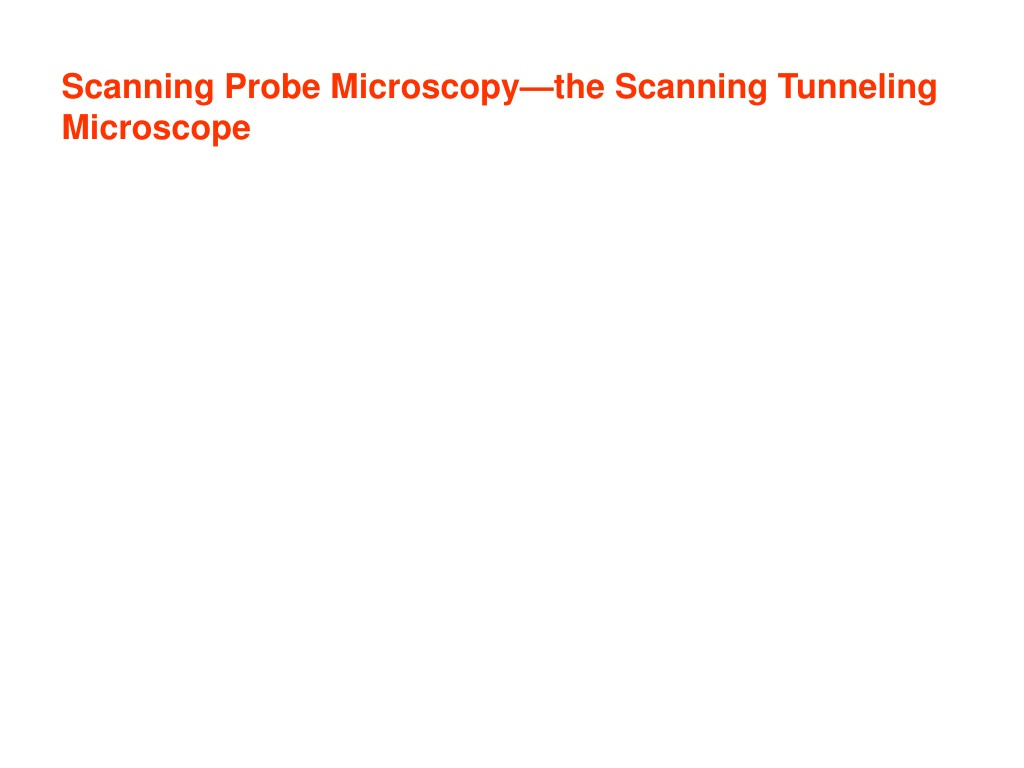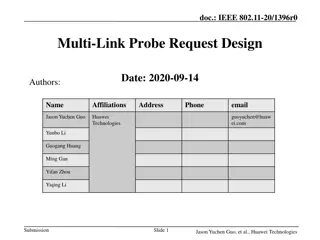Exploring Atomic Dimensions: Scanning Probe Microscopy
Delve into the world of nanoscale imaging with Scanning Probe Microscopy (SPM) techniques like Scanning Tunneling Microscopy (STM) and Atomic Force Microscope (AFM). Unlike optical microscopes, SPM methods break the diffraction limit by relying on intermolecular forces and quantum tunneling for unparalleled resolution down to atomic lengths. Discover how these instruments can visualize structures at the quantum scale, revealing atomic arrangements with remarkable precision and detail.
Download Presentation

Please find below an Image/Link to download the presentation.
The content on the website is provided AS IS for your information and personal use only. It may not be sold, licensed, or shared on other websites without obtaining consent from the author. Download presentation by click this link. If you encounter any issues during the download, it is possible that the publisher has removed the file from their server.
E N D
Presentation Transcript
Scanning Probe Microscopythe Scanning Tunneling Microscope The best optical microscopes can see structures in the 200 400 nm range, at their limits of resolution. The STM can see structures on the order of 0.1 nm [atoms!] another SPM, the AFM can distinguish things on the order of 100 nm [large molecules].
Scanning Probe Microscopythe Scanning Tunneling Microscope The best optical microscopes can see structures in the 200 400 nm range, at their limits of resolution. The STM can see structures on the order of 0.1 nm [atoms!] another SPM, the AFM can distinguish things on the order of 100 nm [large molecules]. Optical microscopes are diffraction limited the wavelength range of visible light (400-750 nm) sets the size of the smallest thing that can be imaged: ~ 400 nm.
Scanning Probe Microscopythe Scanning Tunneling Microscope The best optical microscopes can see structures in the 200 400 nm range, at their limits of resolution. The STM can see structures on the order of 0.1 nm [atoms!] another SPM, the AFM can distinguish things on the order of 100 nm [large molecules]. Scanning Probe Microscopes don t use visible light they depend on measuring intermolecular forces or measuring quantum tunneling. The resolution limits are at the quantum scale (atoms & molecules).
Scanning Tunneling Microscope (STM)measures the shape of a surface to within atomic lengths.
Scanning Tunneling Microscope (STM)measures the shape of a surface to within atomic lengths. Surface atoms
Scanning Tunneling Microscope (STM)measures the shape of a surface to within atomic lengths. STM tip Surface atoms
Scanning Tunneling Microscope (STM)measures the shape of a surface to within atomic lengths. STM tip Surface atoms Battery powered circuit
Scanning Tunneling Microscope (STM)measures the shape of a surface to within atomic lengths. STM tip Surface atoms Battery powered circuit
Scanning Tunneling Microscope (STM)measures the shape of a surface to within atomic lengths. STM tip ?[gap] Surface atoms Battery powered circuit
How does the tip detect the surface? Electron tunneling (a quantum mechanical effect). TIP TUNNELING SURFACE
How does the tip detect the surface? Electron tunneling (a quantum mechanical effect). TIP TUNNELING SURFACE Electrons tunnel from the STM tip to the surface because it is energetically possible for them to do this. So What electric potential does the electron in the STM tip see?
Gap between tip & surface Z Circuit switch is open
Gap between tip & surface VELECTRIC Conduction e- in Tip 0 is the e- energy at z = Z Work function for Tip metal Circuit switch is open
Gap between tip & surface Circuit switch is open and no electrons tunnel across the gap. VELECTRIC Conduction e- in Tip 0 is the e- energy at z = Z Work function for Tip metal Circuit switch is open
Gap between tip & surface Circuit switch is closed and electrons tunnel across the gap. VELECTRIC 0 is the e- energy at z = Z Work function for Tip metal Conduction e- in surface Circuit switch is closed
Gap between tip & surface Circuit switch is closed and electrons tunnel across the gap. VELECTRIC 0 is the e- energy at z = Z Work function for Tip metal Conduction e- in surface Tunneling probability e-Az where constant A depends on gap geometry. Circuit switch is closed
The S in STM stands for scanning which means that the STM Tip moves back and forth across the sample s surface: The picture at left shows the Tip s path, as seen looking toward (into) the surface.
The S in STM stands for scanning which means that the STM Tip moves back and forth across the sample s surface: The picture at left shows the Tip s path, as seen looking toward (into) the surface. Piezo Z-axis Piezo X-axis This means that the tip must move. This is accomplished by three piezo-electric crystals attached to the tip. Piezo Y-axis Each crystal distorts when a voltage is applied across it the STM Tip moves a small distance.
The voltage values applied across the three piezo-electric crystals are used to determine where the STM tip is during its scans.
The voltage values applied across the three piezo-electric crystals are used to determine where the STM tip is during its scans. Voltages [i.e., tip location] and tunneling current strength allow a computer to reconstruct the surface shape, atom by atom.
The voltage values applied across the three piezo-electric crystals are used to determine where the STM tip is during its scans. Voltages [i.e., tip location] and tunneling current strength allow a computer to reconstruct the surface shape, atom by atom. The STM tip can scan one of two ways:
The voltage values applied across the three piezo-electric crystals are used to determine where the STM tip is during its scans. Voltages [i.e., tip location] and tunneling current strength allow a computer to reconstruct the surface shape, atom by atom. The STM tip can scan one of two ways: 1. Keeping the tunneling current constant by moving closer or farther from the surface as the surface falls or rises during a scan.
The voltage values applied across the three piezo-electric crystals are used to determine where the STM tip is during its scans. Voltages [i.e., tip location] and tunneling current strength allow a computer to reconstruct the surface shape, atom by atom. The STM tip can scan one of two ways: 1. Keeping the tunneling current constant by moving closer or farther from the surface as the surface falls or rises during a scan. 2. Keeping at a constant distance above the surface, using the changes in tunneling current strength to determine surface topography.
Using the STM in lab Place the STM tip near the sample surface, by hand; Use the z-axis piezo electric motor to bring the tip close to the surface (within an atomic radius) so that tunneling begins; Use the x-axis and y-axis piezo-electric motors to move the tip over a scan area.
An STM image of a graphite surface taken during Fall 2005 by Davenne Mavour, with image processing by Chuck Pelton.























